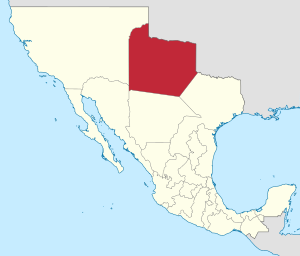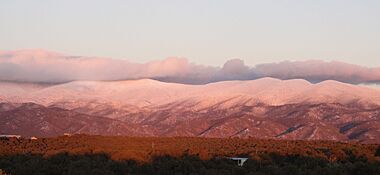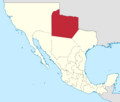Santa Fe de Nuevo México facts for kids
Quick facts for kids Santa Fe de Nuevo México |
|||||||||
|---|---|---|---|---|---|---|---|---|---|
| Kingdom of the Spanish Empire & New Spain (1598–1821) Territory of the First Mexican Empire (1821–23) Territory of the First Mexican Republic (1823–1848) |
|||||||||
| 1598–1846a | |||||||||
 |
|||||||||
| Capital | Santa Fe | ||||||||
| Area | |||||||||
|
•
|
603,345 km2 (232,953 sq mi) | ||||||||
| Government | |||||||||
| Spanish governors | |||||||||
|
• 1598–1610 (first)
|
Juan de Oñate | ||||||||
|
• 1818–1822 (last)
|
Facundo Melgares | ||||||||
| Mexican governors | |||||||||
|
• July – Nov. 1822 (first)
|
Francisco Xavier Chávez | ||||||||
|
• August – Sept. 1846 (last)
|
Juan Bautista Vigil y Alarid | ||||||||
| History | |||||||||
| 1598 | |||||||||
| 1821 | |||||||||
| March 2, 1836 | |||||||||
|
• Mexican–American War
|
from April 25, 1846 | ||||||||
|
• Surrender to U.S. occupation
|
September 1846 | ||||||||
| 2 February 1848 | |||||||||
|
• New Mexico statehood
|
January 6, 1912 | ||||||||
|
|||||||||
| Today part of | United States | ||||||||
| While the Mexican territory theoretically existed until the Mexican Cession under the Treaty of Guadalupe Hidalgo on February 2, 1848, the New Mexico Territory had been annexed under U.S. military occupation in September 1846, after the surrender by Mexican interim governor Juan Bautista Vigil y Alarid to General Stephen W. Kearny. | |||||||||
Santa Fe de Nuevo México (which means Holy Faith of New Mexico in English) was a large area of land. It was first a part of the Spanish Empire and later a territory of independent Mexico.
The first capital was San Juan de los Caballeros from 1598 to 1610. After that, the capital moved to La Villa Real de la Santa Fe de San Francisco de Asís, which is now Santa Fe.
The name "New Mexico" and its capital city, Santa Fe, are still used today. The New Mexico Territory and later the state of New Mexico became part of the United States. People living there, including Hispano, Pueblo, Navajo, Apache, and Comanche peoples, became U.S. citizens after the Treaty of Guadalupe Hidalgo in 1848.
Many people think Nuevo México got its name from the country of Mexico. But the name was used as early as 1561. This was 260 years before Mexico became an independent country. Spanish explorers used el Nuevo México to describe rich cities they heard about far to the north. This name also reminded them of the Mexica people. The Mexica had stories of their homeland, Aztlán, being in the north before they moved to Mexico centuries ago.
Contents
Geography of Nuevo México
Nuevo México was mainly located in the upper valley of the Rio Grande. It stretched from south of Ciudad Juárez all the way north to the Colorado River. This area included most of what is now the American state of New Mexico. It also covered parts of Texas, Colorado, Kansas, and the Oklahoma panhandle.
Actual Spanish towns were mostly around Santa Fe. They went north to Taos pueblo and south to Albuquerque. For most of its history, the capital was Santa Fe. It was nestled in the foothills of the Sangre de Cristo Mountains.
History of the Region
Spanish Rule and Exploration
Early Explorers and Settlements
In 1536, four explorers, including Álvar Núñez Cabeza de Vaca and Estevanico, survived a difficult journey. They wandered for eight years across what is now northern Mexico and the Southwest United States.
Later, in 1539, Fray Marcos de Niza led a group north from Mexico City. He saw a Zuni town from a distance and thought it might be one of the famous Seven Cities of Gold. This led to more expeditions.
From 1540 to 1542, Francisco Vázquez de Coronado led a big expedition. He traveled from present-day Mexico through the Southwest and as far east as Kansas.
In 1598, Don Juan de Oñate Salazar started the Spanish colony of Santa Fe de Nuevo Méjico. This was at a new village called San Juan de los Caballeros. The King of Spain, Philip II, had approved this trip. The Spanish hoped to find gold cities, like the ones the Aztecs had. But their main goal was to spread the Catholic religion. Oñate did not find any riches. As governor, he worked with the Pueblo people and helped establish Spanish rule. He was the first governor of Nuevo México from 1598 to 1610.
Missions and Conflicts
Many Spanish missions were built in Nuevo México in the early 1600s. These missions were small communities. They were centers for Spanish religious and economic life. They also changed the Pueblo way of life.
At these missions, Franciscan priests baptized thousands of Native Americans. Most of these were Pueblo people. The missionaries wanted new converts to join Catholic services. They also destroyed Pueblo religious objects and banned traditional ceremonies. Despite the spread of Catholicism, Pueblo people often practiced their traditional faith in secret.
Some Pueblo communities were friendly at first. But cultural differences and the ban on local religions caused problems. The Spanish also demanded high taxes. Because of these issues, the native communities rebelled in 1680. This event is known as the Pueblo Revolt. The Spanish were forced out of Nuevo México for 12 years. The Pueblo people were able to get their lands back.
In 1692, the Spanish returned. Diego de Vargas led the effort to take back Santa Fe. The province then came under the control of the Viceroy of New Spain in Mexico City.
Mexican Territory
Nuevo México stayed under Spanish control until 1821. That year, Mexico declared its independence. Under Mexico's 1824 Constitution, Nuevo México became a territory managed by the federal government.
The Republic of Texas claimed the part of Nuevo México east of the Rio Grande. Texas became independent from Mexico in 1836. Mexico did not agree with this claim. In 1841, Texans sent an expedition to Santa Fe. They said it was for trade, but they hoped to take control of the area. However, New Mexican troops captured the expedition.
Becoming American Territory
The United States took over Texas's claim to the eastern part of Nuevo México when Texas joined the U.S. in 1845. In 1846, during the Mexican–American War, the U.S. Army moved into the territory. A temporary government was set up.
Mexico officially gave up the territory to the United States in 1848. This happened with the Mexican Cession as part of the Treaty of Guadalupe Hidalgo.
Texas still claimed the eastern part of the territory. But it never fully controlled it, except for El Paso. In 1850, Texas agreed to give up its claims to areas within and north of New Mexico's current borders. In return, Texas received $10 million.
Presidents Zachary Taylor and Abraham Lincoln both suggested that New Mexico become a state right away. This would help avoid arguments about slavery in the territories. Slavery was already against the law in New Mexico.
New Mexico officially became a U.S. state in 1912.
Images for kids
See also
 In Spanish: Santa Fe de Nuevo México para niños
In Spanish: Santa Fe de Nuevo México para niños










